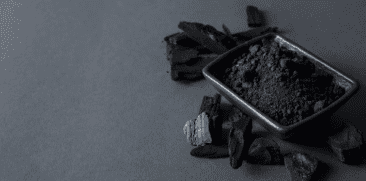
Carbo animalis
Latin name: Carbo animalis
Short name: Carb-an
Common name: Animal Charcoal | Bone Charcoal | Charred Animal Bone | Bone Black | Bone Phosphate Carbon
Primary miasm: Sycotic Secondary miasm(s): Syphilitic
Kingdom: Minerals
Family: Inorganic compound
- Symptomatology
- Remedy Information
- Differentiation & Application
Prepared from the charcoal of animal bones, consisting largely of calcium phosphate, calcium carbonate, and carbon. The bones are charred in closed vessels to retain the phosphates. The tincture is made by trituration of the powder with lactose, followed by dilution and succussion.
In industry, animal charcoal was historically used for sugar refining, water purification, and odour removal due to its high adsorptive capacity. In pharmacy, it has been used to absorb toxins and odours from putrefying matter.
First proved by Hahnemann and published in Chronic Diseases. Further expanded by Hering, Allen, and Clarke from both provings and clinical confirmations.
- Lymphatic system and glands – Tendency to induration of glands, especially cervical, axillary, inguinal, and mammary [Hering].
- Breast tissue – Hard, painful swellings; scirrhous degeneration of the mammary gland [Boericke].
- Mucous membranes – Ulceration of mouth, throat, genitals; foetid discharges.
- Venous system – Passive congestion and stagnation, especially in elderly or cachectic states.
- Digestive tract – Offensive eructations, flatulence, and foul-smelling stools.
- Skin and connective tissue – Hard, knotty, indurated swellings; tendency to ulcerate with acrid discharge.
- Respiratory system – Chronic hoarseness, bronchial catarrh, and foetid expectoration.
- General nutrition – Debility, slow repair, and wasting in scrofulous, cachectic constitutions.
- Warmth of bed and clothing [Kent].
- Rest and avoidance of exertion.
- Eating (temporary relief of some gastric complaints).
- Warm, dry weather.
- Cold air or damp weather.
- Night, especially after midnight.
- Lying on the affected side (breast or lung complaints).
- Fatigue, prolonged talking, or mental exertion.
- Suppressed discharges or perspiration.
- Conium – Glandular induration, especially of breast, but Conium is more suited to stony hardness without offensive discharges.
- Carbo vegetabilis – Similar venous stagnation and debility, but more gastric flatulence and collapse; lacks glandular induration keynote.
- Silicea – Induration with suppuration tendency, but more chilliness and sweat of head.
- Baryta carb. – Indurated glands in children and elderly, with mental weakness more marked.
- Complementary: Silicea, Conium.
- Antidotes: Camphor, Arsenicum.
- Follows well: Sulphur, Lycopodium.
A slow, cold, indurating remedy for chronic degenerative states, especially in debilitated, cachectic constitutions. It addresses glandular hardness, foetid discharges, and venous stagnation. The patient is mentally and physically sluggish, with a deep-seated loss of vitality, often after long illness, grief, or toxic exposure.
- Excellent in scirrhous induration of mammary glands post-lactation or after injury.
- Useful for cancer cachexia where vitality is low and discharges are acrid, offensive.
- In chronic otorrhoea with offensive smell in debilitated subjects.
- For old cicatrices that become indurated or tender.
Mind:
- Gloomy, foreboding.
- Weak memory.
Head:
- Headache from occiput forward.
- Hair falling in chronic illness.
Glands:
- Indurated cervical glands.
- Hard mammary glands.
Mouth/Throat:
- Offensive breath.
- Ulcers with burning pain.
Skin:
- Indurated nodules.
- Old scars painful.
Generalities:
- Debility in aged persons.
- Offensive discharges.
- Hahnemann, S. – Chronic Diseases: Original proving and glandular action.
- Hering, C. – Guiding Symptoms: Induration of glands, mammary cancer, offensive discharges.
- Allen, T.F. – Encyclopaedia: Proving details and modalities.
- Clarke, J.H. – Dictionary: Cachectic states, constitutional notes.
- Kent, J.T. – Lectures: Chronic degeneration, venous stagnation.
- Boericke, W. – Pocket Manual: Cancer diathesis, breast induration.
- Lippe, A. – Keynotes: Aggravations and clinical confirmations.
- Farrington, E.A. – Clinical MM: Cancer cachexia.
- Nash, E.B. – Leaders: Offensive discharges in low vitality states.
- Hughes, R. – Cyclopaedia: Pharmacological commentary.
